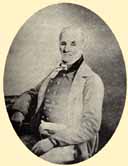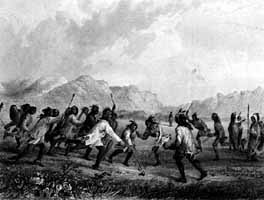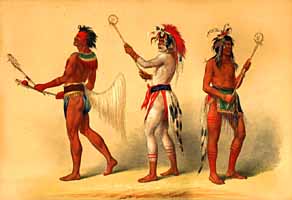

 |
 |
A Canoe Voyage up the Minnay Sotorby George William Featherstonhaugh 1835 |
 |
September 5.--On putting my head out of the tent in the morning, I had the satisfaction of seeing that all my people were alive, with a tremendous deluge of rain pouring upon them. Almost nothing short of a tomahawk will awaken a Canadian voyageur who lies down after his day's work, with six or eight pounds of fat pork and biscuits within him. The torrent came down so incessantly, that we kept snug until about 10 A.M., when it began to abate, and striking the camp, we took to the river again. At 2 P.M. we met a party of soldiers in a canoe, going from Fort Snelling to Prairie du Chien with the mail. I stopped for the men to dine at a place where, upon some trees which the Indians had blazed or cut smooth on one side, figures had been painted in black, and were very tolerably executed. Two Indians were represented, each with a scalped prisoner, and two animals representing their totem, or the tribe they belonged to. A horse was extremely well done, and an Indian dog still better.
 Ball Play on the Prairie |
 LaCrosse Players |
At 3 P.M. we came up with Prairie la Crosse, an extensive slip of low land, so named by the French from the Indians formerly resorting to it to play a game with racket-sticks, resembling very much the Scotch game of golf. About 4 P.M. the sun came out, and we had a beautiful evening: this encouraged the men to get up a chanson, and having all got into good spirits after the constant discomfort we had experienced from the wet weather, I made the signal for landing a little past 5 P.M. at a beautiful slope, with a magnificent escarpment overhanging it. Just as we landed, one of the men knocked a large Tetrao down from a tree, which was cooked for my supper. This bird was not particularly good, and, indeed, was only made tolerable by the slices of ham that were fried along with it; however, I made a hearty supper, and reclining by my cheerful fire, was exceedingly amused in observing the gesticulation of my Canadians, their extreme eagerness about the veriest trifles; incessantly did the sacrés and other profane expressions roll out of their mouths during the conversation which was carrying on betwixt those who were laid down and those who were standing up with their wet blankets spread over their backs to dry at the fire. Certainly a more careless, happy people can hardly be imagined.
September 6.--The rain began to come down in torrents again about 4 A.M., and peeping out of the tent, I saw all the people with their heads and bodies wrapped up in their blankets, profoundly asleep, and snoring as if nothing could awaken them. About 7 A.M. it cleared off again, and whilst they were striking the camp, the serjeant and Beau Pré killed five large birds like the one of the preceding evening. These birds are as yet so unaccustomed to man, that they sometimes permit themselves to be knocked from their roost. About half-past eight we passed a good-looking encampment of twenty Sioux lodges; but the band was gone for the autumnal hunt.
At 10 A.M. we stopped to breakfast within sight of what my people called "La Montagne de Trombalo," of which I had heard a good deal said. At half-past eleven we were in the canoe again. Before we reached Trombalo, we observed many Indian marks upon the white sandstone rocks, which were again becoming the predominant beds, and further on the name of Catlin, the artist, painted in large letters. I wish this enterprising and very clever person had left his portrait on the rock, which he might very conveniently have done, for at this place it comes perpendicularly down to the river. A fine mocassin snake was swimming about here, having perhaps fallen from the rocks; after several attempts I got him alive into the canoe, to the great horror of the Canadians, who have an unconquerable aversion to snakes. With the aid of the serjeant I got the snake skinned very neatly, and afterwards made an excellent specimen of it.
At 2 P.M. we reached Trombalo, and as this rock had attracted a good deal of notice, I determined to examine it carefully. It is not an island, as it has been supposed to be, but is an outlier of the sandstone and limestone bluffs, running nearly a mile and a half east and west, being separated from the west bank of the Mississippi, and not from the east bank, as some travellers have supposed... From this outlier, or part of the bluff; thus standing as it were in the water the early French travellers called it "La Montagne qui trempe à l'Eau," which is now corrupted to Trombalo.
Having ascended to the crest of this Trempe à l'Eau, I found it to be a non-intervention limestone, only three or four yards wide, running from north to south about 200 yards, and falling off in a steep precipice to the west, with compact sandstone at its base. Whilst I was contemplating the magnificent view around me, I saw three Sioux Indians in a canoe approach our fire, and descending, I found the serjeant talking with them, and getting such information from them about the state of the upper country as the few words he possessed enabled him to do. Taking out my list of Sioux words, and pointing to the water, the fire, the trees, &c., they gave me the true pronunciation of the Indian names of these natural objects. I then asked them the name of the mountain at the base of which we were, and they answered "Minnay Chon ka hah,"--literally, as I afterwards found, "Bluff in the Water,"--than which nothing could be more descriptive.